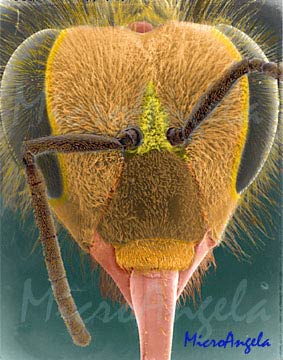

 Honey Bee Honey bees (Apis mellifera) are important as pollinators of many flowering plants and are thus important for many kinds of crops. They also provide us with honey and beeswax. Honey bees collect nectar and pollen as food for their colonies, and pollinate plants as a consequence of their activities. Nectar is stored in the bees special "honey stomach", which is in front of their true stomach. The nectar is passed from worker to worker bee, water is lost, and it changes to honey. It is then stored in cells in the hive and fanned by the bees so that is evaporates further and becomes thicker, then it is sealed in with a wax cap. I used to keep bees, and to harvest the honey I cut the caps off the honeycomb and let the honey drip out. The empty honeycomb can then be returned to the beehive to be filled again. Bees use several senses to locate nectar, find their hive again, and communicate with each other, and they are capable of learning. Some people are afraid of bees because of their sting. This is one of the larger things I have put into our electron microscope. A honeybee is about 12 - 13 mm long (0.5 inches), and its head is about 6 mm (0.25 inches) wide. Can you find one of the smallest things on this web site? |
|
 |
 |
 |
 |
 |
 |
|||||
| Black Ant | House Fly | Honeybee | Fruit Fly | Fly Face | More Bugs |
|
Copyright © 1996-2000 Tina (Weatherby) Carvalho...MicroAngela This material may not be reproduced in any form without express written permission. |